ReviewsBooks
Dec 23, 2015

Māori Art; History, Architecture, Landscape and Theory
Nā Rangihiroa Panoho
Bateman Publishing
RRP: $89.99
Review nā Megan Tamati-Quennell
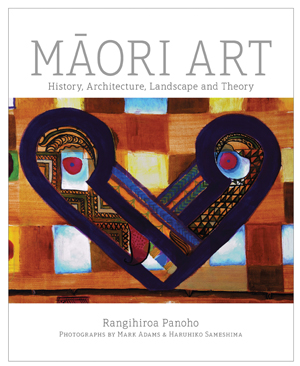 Rangi Panoho’s remarkable new book – Māori Art; History, Architecture, Landscape and Theory – is rich, layered and incredible.
Rangi Panoho’s remarkable new book – Māori Art; History, Architecture, Landscape and Theory – is rich, layered and incredible.
Using Māori metaphor, philosophy, cultural concepts, iwi connection to land and place, cultural narratives, history, and expansive examples drawn from an array of disciplines and sources, Panoho discusses Māori art, its whakapapa, origins, tātai (bloodlines), legacies, and connections.
The book’s scope is vast and expansive, the writing comprehensive. It covers the shifts, changes, and influences within Māori art from our Austronesian origins and Asia/Pacific beginnings to taonga tuku iho, customary, historical, modern, and contemporary Māori art as it evolved in Aotearoa, New Zealand.
Linear time is collapsed and challenged – instead a Māori measure of time is used to create an expansive Māori art history described by Panoho as a Toi Tāhuhu. Like a time-travelling shapeshifter, Panoho moves backwards and forwards, drawing on the concept of ki mua, ki muri – shifting perception and highlighting that the past is in front of us having already happened, the future behind us, yet to arrive.
The foundations for Māori art that Panoho cites are vast, and include the Māori relationship to the Austronesia language group; Asian, Oceanic, and Pacific visual, material, and cultural histories; whakapapa, iwi histories, and narratives; archaeology, ethnology, and anthropology; art, art history and art theory; and also film and literature. His literary references are diverse, poetic, and pertinent, and include quotes and passages from Shakespeare, George Orwell, Ben Okri, and Albert Wendt.
Māori Art; History, Architecture, Landscape and Theory covers the legacies of seminal Māori art figures including Te Kooti Arikirangi Te Turuki, Sir Apirana Ngata, Pineamine Taiapa, and Ralph Hotere. It provides in-depth focus and generous insight into specific histories and Māori art movements such as the introduction and impact of the 1926 Māori Arts and Crafts Act and Ngata’s programme of marae building as a strategy for the maintenance of Māori art; the building of Rangikurukuru (near Dargaville) by Janie Topia, and the work and practice of modern and contemporary artists including Arnold Manaaki Wilson, Paratene Matchitt, Shona Rapira Davies, Emily Karaka, Michael Parekowhai, and Saffronn Te Ratana.
Using the metaphor of water throughout the book in various forms: mātāpuna (parent spring), puna (springs), awa (rivers), river mouths, tributaries, streams, and tides, including the ebb and flow of ideas brought and taken away, “absorbed and rejected” by Māori art, Panoho provides personal and astute observation and critique.
As the title elucidates, Māori Art; History, Architecture, Landscape and Theory covers not only the broad shifts and sweeps that constitute a Toi Tāhuhu – an expansive Māori art history – but also its context. Panoho’s writing is pragmatic at times, and at others lyrical and image-rich. Information and understanding of complex concepts and layered histories are imparted to the reader easily, and with endnotes and sources easily found. Panoho’s text is sublimely supported throughout the publication with the stunning imagery of two leading New Zealand photographers, Mark Adams and Haruhiko Sameshima.
Throughout the book Panoho questions, challenges, and up-ends earlier theories and ideas and offers alternative perspectives, thoughts, and ideas to ruminate on. He offers propositions that are erudite and exciting, that shift ground in the field of Māori art, and, while doing that, ensures throughout the publication that his own position and perspective is evident and clear.
Made up of 10 chapters, Māori Art; History, Architecture, Landscape and Theory begins from a Māori position with a mihi, “a greeting using tribal co-ordinates”, as Panoho describes it. With his mihi Panoho grounds himself in his own whenua, whakapapa, and iwi landscape. He expresses his connection to place – so important in Māori culture and art – and moves out from there, ranging freely across tribal boundaries, disciplines, time periods, and more.
Panoho takes an internal position, writing from the inside out. He reframes and reconceptualises Māori art as a palimpsest. It is a model, he posits, that “resonates with a culture obsessed with origins and descent.” It is a model where the contemporary carries traces of the old, the layers can be seen concurrently, and which does encapsulate the fluidity and flow of Māori art in all its manifestations, its complexity, and multiplicity. Panoho’s Māori art book is epic and extraordinary.
 Megan Tamati-Quennell (Ngāi Tahu) is the Curator of Modern & Contemporary Māori & Indigenous Art at Te Papa. She lives in Wellington with her son Taniora.
Megan Tamati-Quennell (Ngāi Tahu) is the Curator of Modern & Contemporary Māori & Indigenous Art at Te Papa. She lives in Wellington with her son Taniora.
Chappy
Nā Patricia Grace
Publisher: Penguin Books New Zealand
RRP: $38.00
Review nā: Teoti Jardine
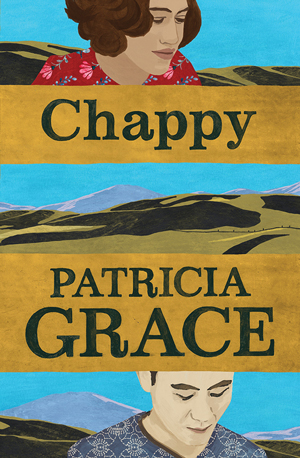 Patricia Grace put a smile on my face from the moment I began to read Chappy. Her invitation to take part in this journey of self-discovery was so tantalisingly irresistible.
Patricia Grace put a smile on my face from the moment I began to read Chappy. Her invitation to take part in this journey of self-discovery was so tantalisingly irresistible.
I travelled with young Daniel who returns to New Zealand seeking to uncover the story of his mysterious grandfather Chappy, and through the process of asking and listening to his Tāua Oriwia and his Great Uncle Tiakiwhenua, Aki, he discovers himself.
Patricia celebrates the importance of the relationships we have with our tāua, pōua, our hākui, hākoro, uncles and aunties, for it’s through them we learn our stories. How often have we heard at tangi, “I meant to ask – now they’ve gone and taken their stories, our stories, with them.”
Patricia covers these engagements with the korowai of honour, patience, and aroha, allowing the storytelling to sit in a place of mutual respect and receptivity.
Using this storytelling as a vehicle, she takes us through some very important times in our recent history: The effects of colonisation and loss of te reo; the wonderful entrepreneurial skills of our old ones as they learned the tools of survival in the modern world; the xenophobia that occurred during and following World War II; and the migration from the familiarity of the papa kāinga to the city, as the young ones left in search of work.
All of the above celebrate who we are as Māori, who we are as Hawaiian, Japanese, and German, and essentially who we are as people. People who have been given this gift of life that allows us to learn who we are, and through this learning, to learn to take care of each other.
This book, Chappy, is a story of aroha, delightfully and skilfully told.
Thank you, Patricia Grace.
 Teoti Jardine is of Māori, Irish and Scottish descent. His tribal affiliations are: Waitaha, Kāti Mamoe, Kāi Tahu. He is a member of the Canterbury Poets Collective Committee and the Kāi Tahu Writers Whānau.
Teoti Jardine is of Māori, Irish and Scottish descent. His tribal affiliations are: Waitaha, Kāti Mamoe, Kāi Tahu. He is a member of the Canterbury Poets Collective Committee and the Kāi Tahu Writers Whānau.
Kūpapa: The Bitter Legacy of Māori Alliances with the Crown
Nā Ron Crosby
Publisher: Penguin Random House
RRP: $65.00
Review nā Gerry Te Kapa Coates
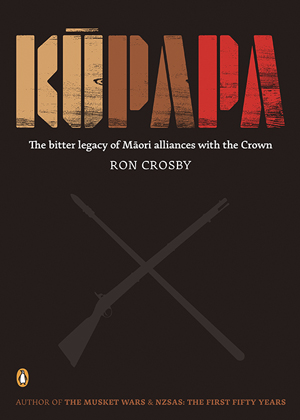 Because Te Ika a Māui was the scene of most of the land wars, Ngāi Tahu appears only twice in this book’s index – the first relating to the visit to Te Waipounamu for some months of two young highly-ranked Ngāti Toa men who had converted to Christianity – Matene Te Whiwhi, the son of Te Rangihaeata’s sister Rangi Toperoa, and Tamihana Te Rauparaha, a son of Te Rauparaha himself. It must have been at considerable risk to themselves to go south in an attempt to cement peaceful relations with Ngāi Tahu, given the continued conflict between Ngāi Tahu and Te Rauparaha. The two men were already supporters from 1853 of the concept of a Māori king as a way to stop the continuing purchase of Māori land, and to reinforce the guarantee of chiefly rangatiratanga in the Treaty.
Because Te Ika a Māui was the scene of most of the land wars, Ngāi Tahu appears only twice in this book’s index – the first relating to the visit to Te Waipounamu for some months of two young highly-ranked Ngāti Toa men who had converted to Christianity – Matene Te Whiwhi, the son of Te Rangihaeata’s sister Rangi Toperoa, and Tamihana Te Rauparaha, a son of Te Rauparaha himself. It must have been at considerable risk to themselves to go south in an attempt to cement peaceful relations with Ngāi Tahu, given the continued conflict between Ngāi Tahu and Te Rauparaha. The two men were already supporters from 1853 of the concept of a Māori king as a way to stop the continuing purchase of Māori land, and to reinforce the guarantee of chiefly rangatiratanga in the Treaty.
The second mention is of Ngāi Tahu leaders Taiaroa and Pita Te Hori, who attended (at the selective invitation of the Crown) the Kohimārama conference in July 1860 – a conference that would have taken a significant toll on their personal travels, as it lasted for a month in the middle of a flu epidemic. The purpose of this meeting was to garner support for the Crown, despite its having launched open warfare defending its Waitara land purchase from Te Teira in 1859. Significantly, supporters of the Kīngitanga movement were not invited to the hui.
In this way Māori became divided over supporters of the Crown and those wanting autonomy through the Kīngitanga movement, setting the scene for a divide and conquer approach. H.W. Williams’ sixth edition of the Dictionary of the Māori Language says the meaning of kūpapa is “to be neutral in a quarrel”, or “to remain quiet, become passive”. Crosby says that when kūpapa first came into usage in the land wars of the 1860s, it was used in reference to Māori who were either neutral, “friendly”, or “loyal” to the Crown. However by 1999, in P.M. Ryan’s Dictionary of Modern Māori, the concept had become almost the opposite – “traitor”. This “extraordinary change in meaning” to collaborator or ally became, as he says, “the equivalent of Uncle Tom” in US parlance. How this happened is covered by this lavishly illustrated 500-page book.
Crosby sums up the complex situation in his brief conclusion. “The rangatira and other Māori who aligned with the Crown or settler Government… were being ‘loyal’ to what was in the best interests of their own rangatira, hapū, or iwi. Loyalty to one’s own… could never create ‘treachery’ or ‘disloyalty’ to another iwi or hapū with different interests.”
HUIA SHORT STORIES 11: Contemporary Māori Fiction
Huia Publishers 2015
RRP: $30.00
Review nā Gerry Te Kapa Coates
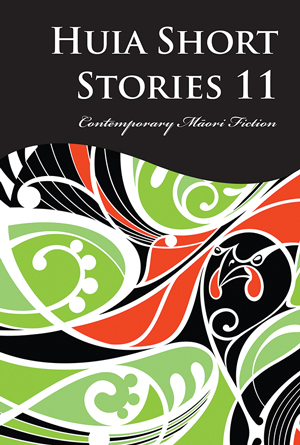 It wasn’t my imagination. This edition is quite a lot shorter, with only 19 finalists compared with 32 and 31 in the two previous editions. I also didn’t see any Ngāi Tahu writers listed, although Aimee Tapping gave no tribal affiliation and at least knew about our dialect. This should have provided a top quality line-up, but I was a bit underwhelmed by several well-written stories that seemed to me to be too stereotypical – such as plucky Māori women with dysfunctional men – without any particular redeeming aspects, or about rather boring subjects.
It wasn’t my imagination. This edition is quite a lot shorter, with only 19 finalists compared with 32 and 31 in the two previous editions. I also didn’t see any Ngāi Tahu writers listed, although Aimee Tapping gave no tribal affiliation and at least knew about our dialect. This should have provided a top quality line-up, but I was a bit underwhelmed by several well-written stories that seemed to me to be too stereotypical – such as plucky Māori women with dysfunctional men – without any particular redeeming aspects, or about rather boring subjects.
The winner of the best short story in English was Toni Pivac, who also appeared in Huia 9 with In the Space of a Moment, about a poignant chance encounter between an abandoned husband looking after their three children, and the woman who had left him four years before. There are several twists in the plot and it hangs together like a TV play, or even the basis for a movie. The best novel extract was by regular finalist Anne French for Hands of Time, about a teenager – Tāne – from an abusive family, whose father is in prison for three years and whose mother is a P addict. Redemption is at hand in the form of a Māori mussel barge owner who offers him the chance to work with him. Another crewman tells him when he confesses he has nowhere to go after the first trip, “You’re one of our family now boy.” A bit too predictable and stereotypical for my liking.
The best of the other stories included Aroha Benson’s The Power of Water, about post-war PTSD; André Hetariki’s Tangaroa’s Promise, vividly reimagining our ancestor’s departure from Rarotonga; Lauren Keenan’s The Job about a habitual fantasist applying for a job beyond his comfort zone; Robert MacDonald’s excellent story Old Tōtara about a man’s kindness to a pregnant woman in dire straits; Anya Ngawhare’s Tired Eyes about racism and sibling friendship (her novel extract was good too); Aimee Tapping’s Kata and Kāpō – an almost young adult story about coming to terms with the death of a best friend; and Helen Waaka’s Eyes of God, a moving story of the trials of aging.
Huia need to be congratulated for hanging in there. This still is a worthwhile endeavour, evidenced by the number of names who keep returning to the fold.
 Gerry Te Kapa Coates (Ngāi Tahu, Waihao) was born in Oamaru. He is the author of a collection of poems and short stories, and widely varied non-fiction. Gerry is a consultant, hearings commissioner, and Māori advisory worker.
Gerry Te Kapa Coates (Ngāi Tahu, Waihao) was born in Oamaru. He is the author of a collection of poems and short stories, and widely varied non-fiction. Gerry is a consultant, hearings commissioner, and Māori advisory worker.
Nā Patricia Grace
Huia Publishers
Illustrations nā Andrew Burdan
RRP: $25.00
Review nā Fern Whitau
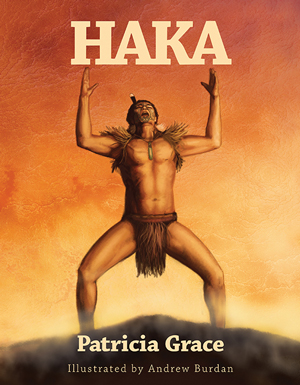 Ka Mate is known as the haka performed before many big All Black games to rouse our modern day New Zealand warriors and strike fear into the hearts of their opponents. Ka Mate is deeply embedded in our New Zealand culture; along with many of our compatriots we make a special effort to watch and be a part of that unique ritual. Many of us are able to recite the first four lines: “Ka mate! Ka mate! Ka ora! Ka ora! Ka mate! Ka mate! Ka ora! Ka ora!” with appropriate actions and passion. This exciting and suspenseful story is a page-turning history of the events that led to the composition of that world famous haka.
Ka Mate is known as the haka performed before many big All Black games to rouse our modern day New Zealand warriors and strike fear into the hearts of their opponents. Ka Mate is deeply embedded in our New Zealand culture; along with many of our compatriots we make a special effort to watch and be a part of that unique ritual. Many of us are able to recite the first four lines: “Ka mate! Ka mate! Ka ora! Ka ora! Ka mate! Ka mate! Ka ora! Ka ora!” with appropriate actions and passion. This exciting and suspenseful story is a page-turning history of the events that led to the composition of that world famous haka.
The story is told to a group of attentive tamariki about Te Rauparaha, a fighting chief of Ngāti Toa who had many foes. Once, while out on an ally-gathering mission, he was forced to hide in a dark, potato pit as his enemies searched for him. Te Rauparaha didn’t know if he would die or live to see the light of day again. On his successful escape from danger he returned home, and with great drama and gesture told of his alarming adventure, of the people who had saved him, and of his escape. The tale was captured forever in his haka, and handed down through the generations to the tamariki in this wonderful picture book.
The eye-catching cover is followed up with more stunning illustrations by Andrew Burdan that perfectly depict the range of emotions expressed within these pages – the ferocity, the fear, the mana, and the excitement. Through this thrilling and informative tale, Patricia Grace, who is also of Ngāti Toa descent, gives us a window into the Māori world view. The reader is given an insight into how concepts such as tapu and noa work in reality.
This is an excellent recount of the conception of an important part of our Aotearoa/New Zealand identity. Children will be thrilled and inspired by it. My workmates who couldn’t walk past my desk without picking up this awesome book were in turn captivated, wowed, and entranced.
 Fern Whitau (Kāi Tahu, Kāti Māmoe, Waitaha) is a te reo Māori advisor at Te Rūnanga o Ngāi Tahu.
Fern Whitau (Kāi Tahu, Kāti Māmoe, Waitaha) is a te reo Māori advisor at Te Rūnanga o Ngāi Tahu.
Opinions expressed in REVIEWS are those of the writers and are not necessarily endorsed by Te Rūnanga o Ngāi Tahu.